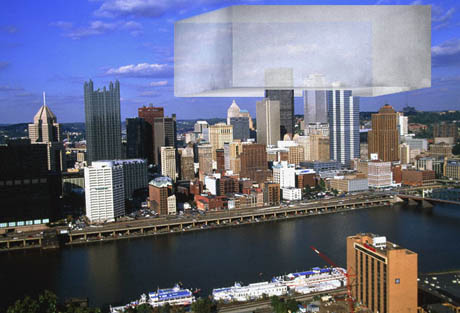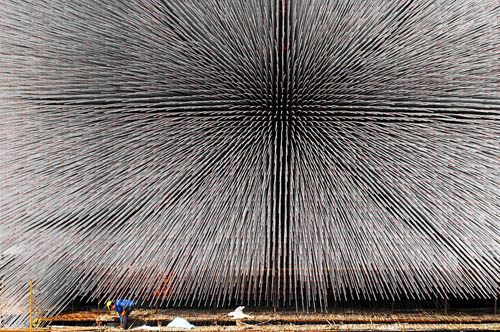Monday, March 29. 2010
Via Jargon, etc.
-----
by jared.langevin@gmail.com (Jared Langevin)
New Scientist published an interesting article this week about the influence of the body's positioning in space on one's thought processes. According to recent research, space and the body are actually much more connected to the mind than has been traditionally accepted. The article cites a study by researchers at the University of Melbourne in Parkville, Australia which found that the eye movements of 12 right handed male subjects could be used to predict the size of each in a series of numbers that the participants were asked to generate; left and downwards meant a smaller number than the previous one, while up and to the right meant a larger number. A separate study at the Max Planck Institute for Psycholinguistics in Nijmegen, the Netherlands, asked 24 students to move marbles from a box on a higher shelf to one on a lower shelf while answering a neutral question, such as "tell me what happened yesterday". The resulted showed that the subjects were more likely to talk of positive events when moving marbles upwards, and negative events when moving them downwards.
Read more about this here.

The notion that our bodies' direct physical relationship to space can influence thoughts is exciting, and reopens arguments against the ontological distinction between mind and body that is most commonly identified with Descartes, as well as associated questions of physical determinism vs. indeterminism . Going further, I suspect that less overt interactions between the body and its surrounding environment could be also included in this discussion, such as the psychological perceptions of temperature, humidity, and other similarly invisible environmental characteristics. The New Scientist article also references a 2008 study from the Rotman School of Management in Toronto that shows that social exclusion has the effect of making people feel colder. The issue of causality abounds here: if social exclusion or inclusion affects a person's temperature perception, would variant temperatures also be able to yield varying types of associated social behavior? Could we extend this discussion to the somewhat perverse notion that a carefully controlled interior environment is actually a form of mind control? ...

A drawing from René Decartes' Meditations on First Philosophy illustrates his
belief that the immaterial (mind, soul, "animal spirit") and material (body)
interact through the pineal gland in the center of the brain.
Via BLDGBLOG
-----
by noreply@blogger.com (Geoff Manaugh)
 [Image: Thesis project by Vincenzo Reale, from a course taught by Alessio Erioli at the University of Bologna; photo by Alessio Erioli]. [Image: Thesis project by Vincenzo Reale, from a course taught by Alessio Erioli at the University of Bologna; photo by Alessio Erioli].
Here are two 3D-printed thesis projects from a course taught by Alessio Erioli at the University of Bologna; above you see work by Vincenzo Reale, below work by Riccardo La Magna. I have to admit to being utterly blown away by the formal possibilities of 3D printers, and these projects only make that obsession more extreme.
 [Image: Thesis project by Riccardo La Magna, from a course taught by Alessio Erioli at the University of Bologna; photo by Alessio Erioli]. [Image: Thesis project by Riccardo La Magna, from a course taught by Alessio Erioli at the University of Bologna; photo by Alessio Erioli].
For one or two more images of these and other thesis projects, check out the Flickr stream of Alessio Erioli, where I originally saw these photos; for more on the future of (an admittedly different kind of) 3D printing, check out the recent, awesome article by Tim Abrahams in Blueprint Magazine: "In a small shed on an industrial park near Pisa is a machine that can print buildings," we read.
The machine itself looks like a prototype for the automotive industry. Four columns independently support a frame with a single armature on it. Driven by CAD software installed on a dust-covered computer terminal, the armature moves just millimetres above a pile of sand, expressing a magnesium-based solution from hundreds of nozzles on its lower side. It makes four passes... The system deposits the sand and then inorganic binding ink. The exercise is repeated. The millennia-long process of laying down sedimentary rock is accelerated into a day. A building emerges. This machine could be used to construct anything.
Mimicking geology, we might forego architecture altogether and print new tectonic plates. Print earthquakes and mountain chains, archipelagoes at sea.
Wednesday, March 24. 2010
Via Edible Geography (full article about scent and architecture, scentscapes)
-----
(...)
I’m reminded here of David Gissen’s ongoing research into atmospheric preservation and reconstruction, such as his proposal for an indoor air archive, which he describes as:
A fantasy archive for the retrieval of future data related to the indoor atmosphere of cities … [built] using the tools we currently have to study the air of the past, but wiring them in reverse.

IMAGE: Reconstruction – Smoke, 2006, by David Gissen. Excitingly, Gissen will be continuing his creative exploration of the design potential of atmospheric reconstruction as part of a forthcoming exhibition (autumn 2011) at the Nevada Museum of Art, alongside fantastic British architects Smout Allen, and curated by Geoff Manaugh of BLDGBLOG.
In the illustration above, Gissen proposes a contained reconstruction of the early twentieth-century atmosphere of Pittsburgh, on the compelling grounds that, “it is difficult to understand much of the architectural work of Pittsburgh from 1900-1950 without an understanding of the former state of the city’s atmosphere.”
(...)
Tuesday, March 23. 2010
Via BLDGBLOG
-----
by noreply@blogger.com (Geoff Manaugh)
 [Image: Thomas Heatherwick's "Seed Cathedral" at the 2010 Shanghai World Expo; photo by Reuters/China Daily, via The Big Picture]. [Image: Thomas Heatherwick's "Seed Cathedral" at the 2010 Shanghai World Expo; photo by Reuters/China Daily, via The Big Picture].
I have to admit that, however over-exposed this building might be, it is one of the coolest architectural constructions I've seen in a long time—and while I say that in the most superficial way imaginable, i.e. I just think it looks really, really cool, this structure, the so-called " Seed Cathedral" by Thomas Heatherwick, under construction in Shanghai for this summer's 2010 World Expo, has an amazing ulterior motive: at the end of every one of the 60,000 transparent acrylic rods that you see fuzzing outward into the sunlight are the seeds of plants.
 [Image: The seeds revealed; photo by Aly Song for Reuters, via The Big Picture]. [Image: The seeds revealed; photo by Aly Song for Reuters, via The Big Picture].
The result looks very much like an expansion of Heatherwick's earlier work Sitooterie II, but the final design incorporates seeds from the Kew Millennium Seed Bank project.
From the New York Times last autumn: "Heatherwick and his team worked with Kew’s Millennium Seed Bank partnership to showcase Britain’s commitment to conservation. They encased thousands of seeds in the ends of the transparent rods, creating a larger-than-life catalog of the plant species that contribute to national and global conservation programs, in a veritable cathedral of seeds."
    [Images: Thomas Heatherwick's "Seed Cathedral" prepares to open in Shanghai; photos by Philippe Lopez/AFP/Getty Images; STR/AFP/Getty Images; and AP; all via The Big Picture]. [Images: Thomas Heatherwick's "Seed Cathedral" prepares to open in Shanghai; photos by Philippe Lopez/AFP/Getty Images; STR/AFP/Getty Images; and AP; all via The Big Picture].
Seed vaults have long been of interest here, of course, but this non-doomsday-inspired celebration of terrestrial botany is, for me, surprisingly much more thrilling than some top secret polar room predicated on an end-of-the-world agricultural scenario. Perhaps every town should have its own seed cathedral, blur-buildings of acrylic rods to showcase their local flora.
Personal comment:
http://www.heatherwick.com/#Thomas Heatherwick
Thursday, March 18. 2010
Imagine a printer that can spit out whole structures like a sculpture, chair or an entire building. Sounds science fiction-y, right? But that's exactly what designer Enrico Dini created with his prototype D-Shape printer. Dini hopes to use the printer to create buildings made of stone and eventually, moon dust! Inhabitat
-----
Via Archinect
Personal comment:
This not something new and is a "dream" shared by many (I think here about François Roche & co, Gramazio Koller, recently Greg Lynn, etc.). Digital fabrication is here for a while, but big digital printing not.
So, wait and see and we'll be able to print out buildings! Which sounds quite exciting I admit!
|


 [Image: Thesis project by Vincenzo Reale, from a course taught by Alessio Erioli at the University of Bologna; photo by
[Image: Thesis project by Vincenzo Reale, from a course taught by Alessio Erioli at the University of Bologna; photo by  [Image: Thesis project by Riccardo La Magna, from a course taught by Alessio Erioli at the University of Bologna; photo by
[Image: Thesis project by Riccardo La Magna, from a course taught by Alessio Erioli at the University of Bologna; photo by 
 [Image: Thomas Heatherwick's "Seed Cathedral" at the 2010 Shanghai World Expo; photo by Reuters/China Daily, via
[Image: Thomas Heatherwick's "Seed Cathedral" at the 2010 Shanghai World Expo; photo by Reuters/China Daily, via  [Image: The seeds revealed; photo by Aly Song for Reuters, via
[Image: The seeds revealed; photo by Aly Song for Reuters, via 


 [Images: Thomas Heatherwick's "Seed Cathedral" prepares to open in Shanghai; photos by Philippe Lopez/AFP/Getty Images; STR/AFP/Getty Images; and AP; all via
[Images: Thomas Heatherwick's "Seed Cathedral" prepares to open in Shanghai; photos by Philippe Lopez/AFP/Getty Images; STR/AFP/Getty Images; and AP; all via 
